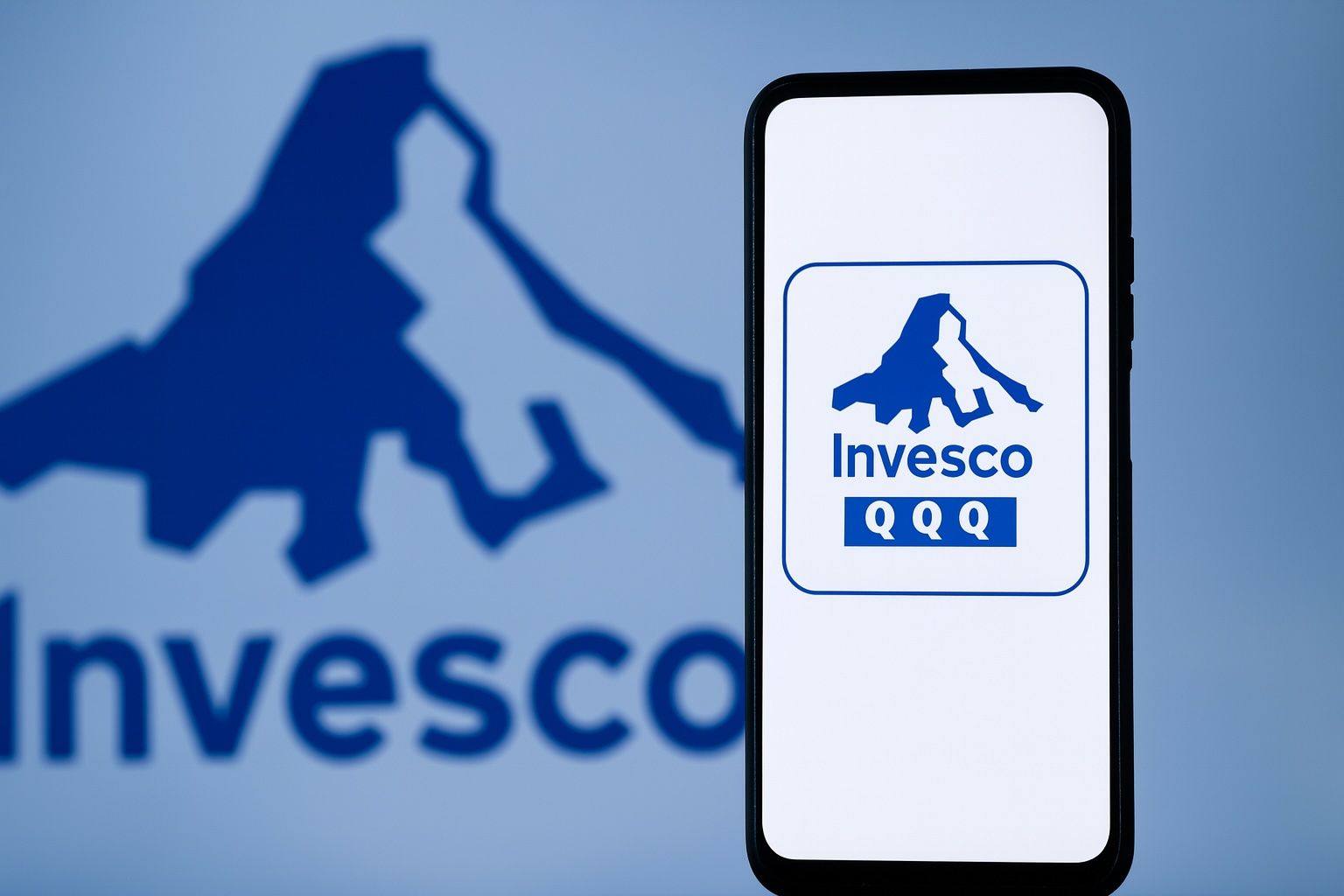Published: November 22, 2025 – Not investment advice. For information and education only.
Key Takeaways
- QQQ is trading near record highs around $590, after a strong double‑digit gain in 2025, but recent pullbacks show investors are nervous about AI valuations and interest‑rate policy. [1]
- The ETF is heavily concentrated in mega‑cap tech and AI leaders, with roughly two‑thirds of its weight in technology and nearly a fifth in consumer discretionary names. [2]
- Earnings growth for the Nasdaq‑100 remains robust (around mid‑teens year‑over‑year in Q3 2025), supporting the bull case into late 2025. [3]
- At the same time, global regulators and big asset managers are warning about a possible AI bubble and stretched valuations, especially in U.S. tech indices like the Nasdaq‑100 that QQQ tracks. [4]
- A reasonable scenario range for QQQ into year‑end 2025 is roughly $470–$680, depending on how the Federal Reserve, AI sentiment, and earnings play out — with high volatility very likely. [5]
What QQQ Is and Why It Matters for 2025
The Invesco QQQ Trust (ticker: QQQ) is an exchange‑traded fund that tracks the Nasdaq‑100 Index, a basket of around 100 of the largest non‑financial companies listed on the Nasdaq. That means it’s packed with the usual megacap suspects: Apple, Microsoft, Nvidia, Amazon, Meta, Alphabet and Tesla, among others. [6]
Sector data from Invesco show that, as of September 30, 2025, technology stocks made up about 64% of QQQ, with consumer discretionary at 18%, health care about 4%, and telecom around 4%. [7] In other words, QQQ is not a broad U.S. market fund. It’s essentially a high‑octane bet on growth and AI‑driven tech.
Another important feature: QQQ is highly concentrated at the top. An analysis earlier in 2025 found that the top 10 holdings represented roughly half of the fund’s assets. [8] That concentration magnifies both upside and downside. When megacaps rally, QQQ tends to rip higher. When a handful of them stumble, the ETF can slide fast.
Over longer periods, that risk has been rewarded. Invesco’s performance data show roughly 140% cumulative return over the last five years (through late October 2025), easily outpacing broad U.S. benchmarks. [9] But history also includes brutal drawdowns — especially when valuations compress.
Where QQQ Stands Now: Price, Performance and Flows
As of November 22, 2025, QQQ trades around $590 per share, close to all‑time highs. Performance has been strong:
- Invesco reports that year‑to‑date through September 30, 2025, QQQ returned about 17.9%, beating both the S&P 500 and the Russell 1000 Growth index. [10]
- Schwab’s performance data show that, by October 31, 2025, QQQ’s YTD total return had climbed to the low‑20s percent range, again ahead of the large‑growth peer group and the Nasdaq‑100 total‑return index. [11]
Investor appetite has stayed strong as well. Invesco’s monthly review notes that QQQ took in nearly $3 billion of inflows in September alone and ended the month with roughly $385 billion in assets under management, underscoring its role as a go‑to vehicle for growth and AI exposure. [12]
At the same time, the last few weeks have brought sharp swings in tech. The Nasdaq‑100 recently led a broader sell‑off, dropping around 1.1% in a single session as concerns about stretched valuations and weakening labor data hit sentiment, driving the VIX volatility index higher. [13]
So QQQ sits at an interesting crossroads: near record highs, richly valued, but still backed by strong earnings growth and massive AI spending.
Macro Backdrop: Fed Uncertainty and the Late‑2025 Economy
The Fed’s Next Steps Matter More Than Usual
For a growth‑heavy ETF like QQQ, interest rates are everything. Higher rates reduce the present value of long‑dated cash flows, which hits high‑growth tech names hardest.
Right now, the Federal Reserve’s path into late 2025 is unusually murky:
- Economists and Fed watchers are split on whether the Fed will cut rates at its December meeting; the policy committee itself is divided between “hawks” who want higher‑for‑longer and “doves” pushing for cuts. [14]
- After a stronger‑than‑expected jobs report, Morgan Stanley dropped its call for a December 2025 rate cut, pushing its expected easing cycle into 2026 instead. [15]
- Vanguard’s fixed‑income team has warned that markets may be pricing in too many future cuts, arguing that strong growth fueled by AI investment could keep the Fed cautious. [16]
CME’s FedWatch tool shows traders constantly tweaking rate‑cut odds as new data roll in, highlighting just how sensitive markets are to each data release. [17]
For QQQ, a benign backdrop would be modest disinflation, steady (not booming) growth and at least the prospect of cuts in 2026 — a combo that keeps real yields contained without signaling a deep recession.
Volatility as the “New Normal”
This tug‑of‑war between stronger economic data and hopes for easier policy is already producing whipsaw price action. On some days, AI and chip stocks surge on strong earnings; on others, they slide on worries about an “AI bubble” and fading rate‑cut hopes, dragging QQQ with them. [18]
Heading into year‑end 2025, macro uncertainty is a key source of risk for any QQQ forecast. Even if earnings hold up, another spike in yields or a surprise from the Fed could trigger fast multiple compression.
The AI Boom: QQQ’s Biggest Tailwind — and Its Main Risk
Earnings Power: AI as a Real Business, Not Just Hype
Unlike the dot‑com bubble, the current AI cycle is already showing up in hard earnings numbers:
- Nvidia’s latest quarterly report delivered about $57 billion in revenue, mostly from data‑center AI chips, with guidance pointing to $65 billion in revenue next quarter and a pipeline of around $500 billion in AI chip orders through 2025–2026. [19]
- Meta has raised its 2025 capital expenditure forecast to roughly $64–72 billion, heavily skewed toward AI infrastructure. [20]
- Alphabet continues to invest heavily after unveiling a new version of its Gemini AI system, which it says marks a “massive jump” in reasoning and coding performance. [21]
These are not tiny, speculative bets. They’re multi‑tens‑of‑billions of dollars in committed capex from QQQ’s largest constituents, aimed at AI data centers, chips and software.
Nasdaq’s own data show the Nasdaq‑100’s net income growing around 16% year over year in Q3 2025, marking the tenth straight quarter of >15% growth — with tech leading the way. [22] That earnings momentum is the core of the bull case for QQQ into the end of 2025.
Bubble Warnings: Everyone Is Watching the Same Trade
The flip side is that everyone also knows QQQ is the AI trade, and major institutions are starting to sound alarms:
- The Bank of England has warned that AI‑related tech valuations look “stretched” and that a sharp correction in U.S. tech indices could trigger a broader global sell‑off. [23]
- The IMF and other institutions have flagged AI as a potential bubble risk, comparing today’s enthusiasm to the late‑1990s dot‑com period. [24]
- Reuters recently highlighted growing concerns that AI stock valuations mirror the early stages of the dot‑com bubble, even as earnings remain strong. [25]
Even within the tech industry, some leaders are uneasy. Google CEO Sundar Pichai has warned about “irrationality” in AI spending and suggested that no company, including Google itself, would be immune if an AI bubble bursts. [26]
Put simply: fundamentals look strong, but expectations are sky‑high. That combination can sustain rallies — until sentiment flips.
Valuation Snapshot: How Expensive Is QQQ Right Now?
Different data providers give slightly different numbers, but they tell a similar story:
- Estimates based on QQQ and the Nasdaq‑100 suggest a trailing P/E ratio around 32–33x, above the long‑term median in the mid‑20s and at the upper end of the last five years. [27]
- Forward P/E ratios cluster roughly in the mid‑20s to high‑20s, versus a historical median closer to the mid‑20s, indicating the index is expensive but not at outright bubble extremes. [28]
A recent Nasdaq analysis argued that AI bubble fears may be overstated, noting that while the Nasdaq‑100 now trades at a premium to history, the gap is not as extreme as in 2000 and is partly justified by better earnings quality and growth. [29]
On the other hand, valuation trackers like GuruFocus and WorldPERatio note that current multiples are above typical ranges and flag the Nasdaq‑100 as “overvalued” relative to five‑year averages. [30]
The takeaway for a QQQ forecast is straightforward:
Valuations won’t necessarily kill the rally on their own — but they make QQQ more sensitive to any negative surprise in earnings, AI sentiment, or Fed policy.
Bull Case: Why QQQ Could Finish 2025 Near or Above Current Highs
If you’re looking at a constructive scenario for QQQ into the final weeks of 2025, it typically rests on four pillars:
- Earnings Keep Beating Expectations
The Nasdaq‑100 has already delivered ten straight quarters of double‑digit earnings growth. If Q4 guidance holds and megacap tech keeps surprising to the upside — particularly AI leaders like Nvidia, Microsoft and Meta — the market can “grow into” its valuation and even support a modest further multiple expansion. [31] - The Fed Stays on Hold, Not on the Warpath
As long as inflation stays contained and the Fed is seen as either pausing or inching toward eventual cuts (even if those cuts are in 2026), long‑duration assets like QQQ usually benefit. Vanguard’s view that growth remains solid but inflation manageable fits a “soft landing” narrative that supports growth stocks. [32] - AI Capex Proves Sticky
Despite bubble talk, big‑tech spending plans — billions for AI chips, data centers and software platforms — suggest multi‑year demand, not a one‑quarter fad. If corporate customers continue signing long‑term AI infrastructure deals, markets may start treating AI like cloud computing: cyclical at times, but fundamentally durable. [33] - ETF Flows Stay Positive
Invesco’s data show strong inflows and record assets in QQQ. If retail investors and institutions keep using QQQ as a core vehicle for AI and growth exposure, that demand can help absorb volatility and support prices into year‑end. [34]
Under this bull case, QQQ could plausibly add another 10–15% from current levels by the end of 2025 — putting it in a rough $650–$680 zone — if sentiment stabilizes and AI optimism regains momentum. [35]
Bear Case: Why QQQ Could Correct Sharply Before 2025 Ends
The bear case focuses less on earnings collapsing and more on multiples compressing from stretched levels:
- A Harder‑Line Fed or Surprise Inflation
If inflation prints come in hot or the labor market re‑accelerates, the Fed could talk down rate‑cut expectations or even hint at further tightening, which would raise real yields. We’ve already seen how quickly economists and banks (like Morgan Stanley) shift their rate‑cut timelines after one strong jobs report. [36] - AI Bubble Narrative Takes Over
Should a few high‑profile AI names miss earnings or cut guidance, the narrative could swing from “AI is eating the world” to “this was a bubble all along.” With the Bank of England, the IMF and major asset managers openly warning about AI‑driven bubbles, investors may be quick to hit the sell button. [37] - Concentration Risk Bites
The top 10 stocks make up roughly half of QQQ. If just one or two — say, Nvidia or a leading cloud provider — suffer a major rerating, QQQ can’t hide in smaller holdings the way a broad index might. [38] - Macro or Political Shocks
Trade tensions, regulatory crackdowns on big tech, or a geopolitical event could all trigger a “risk‑off” move. The Bank of England has also warned about broader financial stability risks tied to U.S. politics and global debt levels, which could amplify volatility. [39]
In a more negative scenario where multiples compress and volatility spikes, a 10–20% drawdown from current levels into year‑end is not hard to imagine, which would imply QQQ trading somewhere in the $470–$530 range. [40]
Base Case: A Wide, Choppy Range for QQQ Into Year‑End 2025
Given the mix of strong fundamentals and elevated valuations, a middle‑of‑the‑road base case for QQQ into the end of 2025 looks something like this:
- Earnings remain solid and AI capex continues, but markets become more selective and less willing to pay ever‑higher multiples. [41]
- The Fed stays cautious but not aggressively hawkish, leaving rate‑cut expectations mostly pushed into 2026. [42]
- AI bubble headlines continue, but no single shock is big enough to completely break sentiment, leading to bouts of selling followed by bargain‑hunting. [43]
Under that base case, it’s reasonable to expect QQQ to finish 2025 within about ±5% of its current level, which corresponds to a broad $560–$620 range — effectively a sideways but noisy market around today’s highs. [44]
Of course, markets rarely behave “reasonably” in the short term, so any of these scenarios could be wrong — or we could see all three within a few volatile weeks.
What This Forecast Means for Investors
For anyone considering QQQ into the end of 2025, a few practical points:
- Know What You’re Actually Buying
QQQ is not a diversified U.S. market ETF. It’s a concentrated, high‑growth, AI‑heavy vehicle that can swing much more than the S&P 500, both up and down. [45] - Short‑Term Outcomes Are Highly Uncertain
With QQQ already near record highs, valuation multiples stretched, and the Fed’s next moves unclear, short‑term price targets are guesses, not guarantees. The forecast ranges above ($470–$680) are scenario bands, not predictions. [46] - Long‑Term Case Depends on AI Delivering Real Returns
Over five‑ and ten‑year horizons, QQQ’s outperformance has been impressive, but it has relied on big tech continuing to compound earnings. If AI investments generate durable profits, that story can continue; if they disappoint, the ETF’s high concentration could work in the opposite direction. [47] - Risk Management Matters More Than Precision
Position sizing, time horizon, and diversification probably matter more than nailing a specific year‑end price. Even bullish commentators on QQQ and the Nasdaq‑100 routinely emphasize that investors must be prepared for sudden double‑digit pullbacks. [48]
Bottom Line
Between now and December 31, 2025, QQQ’s path will likely be driven by three forces:
- AI earnings and capex updates from the megacaps that dominate the ETF.
- Shifts in rate‑cut expectations as the Fed reacts to incoming data.
- Investor psychology around whether AI is the next great secular growth wave or the next big bubble.
Today’s data suggest strong fundamentals but fragile sentiment. That’s a recipe for high volatility in both directions rather than a smooth march higher.
For traders, that may mean opportunity — but also elevated risk. For long‑term investors, it underscores the importance of understanding QQQ’s concentration, accepting the possibility of large drawdowns, and aligning any position with your own risk tolerance and financial plan.
Again, nothing here is a recommendation to buy, sell, or hold QQQ. It’s a framework to think about QQQ’s forecast into the end of 2025, based on the latest earnings, macro data and valuation metrics available today.
References
1. www.schwab.wallst.com, 2. www.invesco.com, 3. www.nasdaq.com, 4. www.theguardian.com, 5. www.gurufocus.com, 6. www.invesco.com, 7. www.invesco.com, 8. seekingalpha.com, 9. www.invesco.com, 10. www.invesco.com, 11. www.schwab.wallst.com, 12. www.invesco.com, 13. www.roic.ai, 14. www.investopedia.com, 15. www.reuters.com, 16. www.ft.com, 17. www.cmegroup.com, 18. nypost.com, 19. www.businessinsider.com, 20. www.nasdaq.com, 21. www.nasdaq.com, 22. www.nasdaq.com, 23. www.theguardian.com, 24. apnews.com, 25. www.reuters.com, 26. nypost.com, 27. worldperatio.com, 28. en.macromicro.me, 29. www.nasdaq.com, 30. www.gurufocus.com, 31. www.nasdaq.com, 32. www.ft.com, 33. www.businessinsider.com, 34. www.invesco.com, 35. www.schwab.wallst.com, 36. www.reuters.com, 37. www.theguardian.com, 38. seekingalpha.com, 39. www.theguardian.com, 40. www.gurufocus.com, 41. www.nasdaq.com, 42. www.ft.com, 43. www.reuters.com, 44. www.schwab.wallst.com, 45. www.invesco.com, 46. www.gurufocus.com, 47. www.invesco.com, 48. www.nasdaq.com










